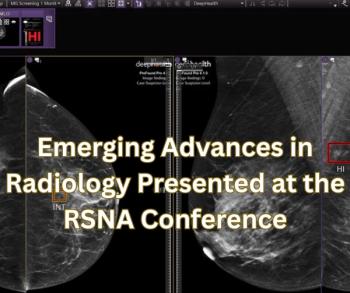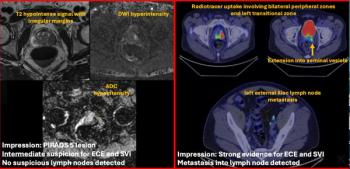
MRI in Early Pregnancy Not Associated with Increased Fetal Risk
MRI during the first trimester of pregnancy does not appear to increase risk of stillbirth or neonatal death, but gadolinium cautioned.
Exposure to MRI during the first trimester of pregnancy does not appear to be associated with an increased risk of harm to the fetus, according to a study published in
Researchers from Canada evaluated the long-term safety of fetuses after women underwent MRI within the first semester of their pregnancy or were exposed to gadolinium at any time during their pregnancy.
Using the universal health care database in the province of Ontario, the researchers identified 1,418,451 deliveries, with a mean gestational age of 39 weeks; 1,420,88 were included in the analysis of MRI during the first trimester, and 1,418,848 in the analysis of gadolinium-enhanced MRI any time throughout the pregnancy. An overall rate of MRI among the pregnancies was 3.97 per 1,000. There were 1,737 MRIs performed during the first trimester, compared to 1,418,451 pregnancies without MRI exposure. Most MRIs were performed during two to five weeks’ gestation. Thirteen percent of women who had a gadolinium-MRI had at least one other MRI with gadolinium during her pregnancy.
The results showed 19 stillbirths or deaths in the first-trimester MRI group, compared to 9,844 in the unexposed group, for an adjusted risk difference of 4.7 per 1,000 person years. “Among those exposed, the rate of stillbirth was higher for mothers exposed to first-trimester MRI (2.8 percent) or gadolinium-enhanced MRI (1.7 percent) than those not exposed (1.1 percent),” the authors wrote. The researchers also did not find a significantly higher rate among the MRI exposed fetuses for congenital anomalies, neoplasm, or vision or hearing loss.[[{"type":"media","view_mode":"media_crop","fid":"52036","attributes":{"alt":"Joel G. Ray, MD","class":"media-image media-image-right","id":"media_crop_4832053842048","media_crop_h":"0","media_crop_image_style":"-1","media_crop_instance":"6446","media_crop_rotate":"0","media_crop_scale_h":"0","media_crop_scale_w":"0","media_crop_w":"0","media_crop_x":"0","media_crop_y":"0","style":"height: 238px; width: 170px; border-width: 0px; border-style: solid; margin: 1px; float: right;","title":"Joel G. Ray, MD","typeof":"foaf:Image"}}]]
"Having an MRI at the earliest stages of pregnancy does not seem to alter the development of the fetus," co-author Joel G. Ray, MD, a physician and researcher at St. Michael's Hospital in Toronto and an adjunct scientist at the Institute for Clinical Evaluative Sciences (ICES), said in a release.
Comparing the 397 women who were exposed to gadolinium during their pregnancy to the no-MRI cohort, there were seven stillbirths and neonatal deaths in the exposed group compared to 9,844 in the unexposed pregnancies, for an adjusted risk difference of 4.75 per 1,000 pregnancies. The hazard ratio for nephrogenic systemic fibrosis (NSF-like) outcomes among the MRI group was also not statistically significant. The broader outcome of any rheumatological, inflammatory, or infiltrative skin condition, occurred in 123 births versus 384,180 birth in the non-exposed group, for an adjusted risk difference of 45.3 per 1,000 person years. The researchers suggested that although the numbers were low, the results support clinical guidelines to avoid giving pregnant women gadolinium unless strongly indicated.
The researchers did not include the reasons why an MRI was ordered or if the women knew they were pregnant at the time of the imaging. However, since 44%of ordering physicians were family physicians, this could suggest the MRI may have been booked prior to a woman having conceived. The other common specialty was a neurologist or neurosurgeon.
Newsletter
Stay at the forefront of radiology with the Diagnostic Imaging newsletter, delivering the latest news, clinical insights, and imaging advancements for today’s radiologists.




























